Abstract
Summary
In a random sample of postmenopausal Chinese women, the prevalence of radiographic vertebral fractures increased from 13% between ages 50 and 59 to over 50% after age 80 years. A model with seven clinical risk factors predicted the probability of vertebral fractures as well with as without BMD and better than a model with only three risk factors. More than half an hour of outdoor activity per day might correlate with lower risk of vertebral fracture in this population.
Introduction
We aimed to describe the prevalence and develop a model for prediction of radiographic vertebral fractures in a large random sample of postmenopausal Chinese women.
Methods
We enrolled 1760 women from an age-stratified random sample of postmenopausal women in Beijing, China. The presence of vertebral fracture was assessed by semi-quantitative grading of lateral thoracolumbar radiographs, risk factors by interview, bone mineral density (BMD) of the proximal femur and lumbar spine by dual x-ray absorptiometry (DXA), and markers of bone turnover from a fasting blood sample. Associations of these factors were analyzed in logistic models and discrimination by areas of receiver operating characteristics curves (AUC).
Results
The prevalence of vertebral fracture, ranged from 13.4% ages 50 to 59 years old to 58.1% at age 80 years or older. Older age, a history of non-vertebral fracture, lower femoral neck BMD T-score, body mass index (BMI), height loss, housework, and less than half an hour of outdoor activity were significantly associated with increased probability of having a vertebral fracture. A model with those seven factors had a similar AUC with or without BMD and performed better than a simple model with three factors.
Conclusion
This study is from a true random sample of postmenopausal women in urban China with high response rate. The prevalence of vertebral fractures in postmenopausal women in Beijing increases from 13% under age 60 to over 50% by age 80 years. A model with seven clinical risk factors with or without BMD is better than simple models and may guide the use of spine x-rays to identify women with vertebral fractures. More than half an hour of outdoor activity might correlate with lower risk of vertebral fracture in this population.

Similar content being viewed by others
References
Cummings SR, Melton LJ (2002) Epidemiology and outcomes of osteoporotic fractures. Lancet 359:1761–1767
Kanis JA, Johnell O, De Laet C et al (2004) A meta-analysis of previous fracture and subsequent fracture risk. Bone 35:375–382
Delmas PD, Genant HK, Crans GG et al (2003) Severity of prevalent vertebral fractures and the risk of subsequent vertebral and nonvertebral fractures: results from the MORE trial. Bone 33:522–532
O'Neill TW, Cockerill W, Matthis C et al (2004) Back pain, disability, and radiographic vertebral fracture in European women: a prospective study. Osteoporos Int 15:760–765
Nevitt MC, Ettinger B, Black DM, Stone K, Jamal SA, Ensrud K, Segal M, Genant HK, Cummings SR (1998) The association of radiographically detected vertebral fractures with back pain and function: a prospective study. Ann Intern Med 128:793–800
Kado DM, Browner WS, Palermo L, Nevitt MC, Genant HK, Cummings SR (1999) Vertebral fractures and mortality in older women: a prospective study. Arch Intern Med 159:1215–1220
Black DM, Delmas PD, Eastell R et al (2007) Once-yearly zoledronic acid for treatment of postmenopausal osteoporosis. New Engl J Med 356:1809–1822
Cummings SR, San Martin J, McClung MR et al (2009) Denosumab for prevention of fractures in postmenopausal women with osteoporosis. New Engl J Med 361:756–765
Chen P, Miller PD, Delmas PD, Misurski DA, Krege JH (2006) Change in lumbar spine BMD and vertebral fracture risk reduction in teriparatide-treated postmenopausal women with osteoporosis. J Bone Miner Res 21:1785–1790
Kanis JA (2002) Diagnosis of osteoporosis and assessment of fracture risk. Lancet 359:1929–1936
Kanis JA, Johansson H, Johnell O et al (2005) Alcohol intake as a risk factor for fracture. Osteoporos Int 16:737–742
Kanis JA, Johnell O, Oden A et al (2005) Smoking and fracture risk: a meta-analysis. Osteoporos Int 16:155–162
Wong SYS, Kwok T, Woo J et al (2005) Bone mineral density and the risk of peripheral arterial disease in men and women: results from Mr. and Ms Os, Hong Kong. Osteoporos Int 16:1933–1938
Ling X, Cummings SR, Mingwei Q et al (2000) Vertebral fractures in Beijing, China: the Beijing osteoporosis project. J Bone Miner Res 15:2019–2025
Xia WB, He SL, Xu L et al (2012) Rapidly increasing rates of hip fracture in Beijing, China. J Bone Miner Res 27(1):125
Genant HK, Wu CY, van Kuijk C, Nevitt MC (1993) Vertebral fracture assessment using a semiquantitative technique. J Bone Miner Res 8:1137–1148
Hosmer DW, Hosmer T, Le Cessie S, Lemeshow S (1997) A comparison of goodness-of-fit tests for the logistic regression model. Stat Med 16:965–980
Pulkstenis E, Robinson TJ (2002) Two goodness-of-fit tests for logistic regression models with continuous covariates. Stat Med 21:79–93
Pencina MJ, D'Agostino RB Sr, D'Agostino RB Jr, Vasan RS (2008) Evaluating the added predictive ability of a new marker: from area under the ROC curve to reclassification and beyond. Stat Med 27(2):157–172
Suman Kundu YSA, A. Cecile J.W. Janssens Package 'PredictABEL', URL: http://www.genabel.org/packages/PredictABEL
Team RC 2013 R: A language and environment for statistical computing. R Foundation for Statistical Computing, Vienna, Austria. URL http://www.R-project.org/
JOSEPH MELTONL et al (1989) Epidemiology of vertebral fractures in women. Am J Epidemiol 129(5):1000–1011
Tromp AM, Ooms ME, Popp-Snijders C, Roos JC, Lips P (2000) Predictors of fractures in elderly women. Osteoporos Int 11:134–140
Albertsson D, Mellstrom D, Petersson C, Thulesius H, Eggertsen R (2010) Hip and fragility fracture prediction by 4-item clinical risk score and mobile heel BMD: a women cohort study. BMC Musculoskel Dis 11:55
Bow CH, Tsang SW, Loong CH, Soong CS, Yeung SC, Kung AW (2011) Bone mineral density enhances use of clinical risk factors in predicting ten-year risk of osteoporotic fractures in Chinese men: the Hong Kong osteoporosis study. Osteoporos Int 22:2799–2807
Kanis JA, McCloskey E, Johansson H, Oden A, Leslie WD (2012) FRAX((R)) with and without bone mineral density. Calcif Tissue Int 90:1–13
Nevitt MC, Cummings SR, Stone KL et al (2005) Risk factors for a first-incident radiographic vertebral fracture in women ≥65 years of age: the study of osteoporotic fractures. J Bone Miner Res 20:131–140
Borer KT (2005) Physical activity in the prevention and amelioration of osteoporosis in women. Sports Med 35(9):779–830
Nelson ME, Rejeski WJ, Blair SN, Duncan PW, Judge JO, King AC, Macera CA, Castaneda-Sceppa C (2007) Physical activity and public health in older adults: recommendation from the American College of Sports Medicine and the American Heart Association. Med Sci Sport Exer 39:1435–1445
Pollintine P, Dolan P, Tobias JH, Adams MA (2004) Intervertebral disc degeneration can lead to “stress-shielding” of the anterior vertebral body: a cause of osteoporotic vertebral fracture? Spine 29(7):774–782
Chang, Y. F.,Chang, C. S. (2016) Effects of age and body mass index on thoracolumbar spine x-ray for diagnosing osteoporosis in elderly women: Tianliao old people (TOP) Study 07. PLoS One 11(9)
Pirro M, Fabbriciani G, Leli C (2010) High weight or body mass index increase the risk of vertebral fractures in postmenopausal osteoporotic women. J Bone Miner Metab 28(1):88–93
Sanfélix-Gimeno G, Sanfelix-Genovés J, Hurtado I (2013) Vertebral fracture risk factors in postmenopausal women over 50 in Valencia, Spain. A population-based cross-sectional study. Bone 52(1):393–399
Nielson CM, Marshall LM (2011) BMI and fracture risk in older men: the osteoporotic fractures in men study (MrOS). J Bone Miner Res 26(3):496–502
Couris CM, Chapurlat RD, Kanis (2012) FRAX® probabilities and risk of major osteoporotic fracture in France. Osteoporos Int 23(9):2321–2327
De Laet C, Kanis JA, Odén A (2005) Body mass index as a predictor of fracture risk: a meta-analysis. Osteoporos Int 16(11):1330–1338
Herrera A, Mateo J, Gil-Albarova J (2015) Prevalence of osteoporotic vertebral fracture in Spanish women over age 45. Maturitas 80(3):288–295
Xu W, Perera S, Medich D (2011) Height loss, vertebral fractures, and the misclassification of osteoporosis. Bone 48(2):307–311
Tobias JH, Hutchinson AP, Hunt LP (2007) Use of clinical risk factors to identify postmenopausal women with vertebral fractures. Osteoporos Int 18(1):35–43
Siminoski K, Warshawski RS, Jen H (2006) The accuracy of historical height loss for the detection of vertebral fractures in postmenopausal women. Osteoporos Int 17(2):290–296
Gunnes M, Lehmann EH, Mellstrom D (1996) The relationship between anthropometric measurements and fractures in women. Bone 19(4):407–413
Edward TM, Eric DG, Susan AS (2009) Which women should be selected for vertebral fracture assessment? Comparing different methods of targeting VFA. Calcified Tissue Int 85(3):203–210
Chinese Society of Osteoporosis And Bone Mineral Research (2011) Guidelines for diagnosis and treatment of primary osteoporosis 2011. Chin J Osteoporosis and Bone Miner Res 04(1):2–17
Acknowledgements
This study was supported by a grant from The Ministry of Science and Technology of the People’s Republic of China (National Public Welfare Research Program 2005DIB1J085, National Key Technology R &D Program 2006BAI03B03, and National Science and Technology Major Projects for “Major New Drugs Innovation and Development” 2008ZX09312-016), National Natural Science Foundation of China (No.81070687 and 81170805), Beijing Natural Science Foundation (No. 7121012), Scientific Research Foundation of Beijing Medical Development (No. 2007-3029), and National Key Program of Clinical Science (WBYZ2011-873).
Author information
Authors and Affiliations
Corresponding author
Ethics declarations
Conflict of interest
None.
Rights and permissions
About this article
Cite this article
Cui, L..., Chen, L., Xia, W. et al. Vertebral fracture in postmenopausal Chinese women: a population-based study. Osteoporos Int 28, 2583–2590 (2017). https://doi.org/10.1007/s00198-017-4085-1
Received:
Accepted:
Published:
Issue Date:
DOI: https://doi.org/10.1007/s00198-017-4085-1




